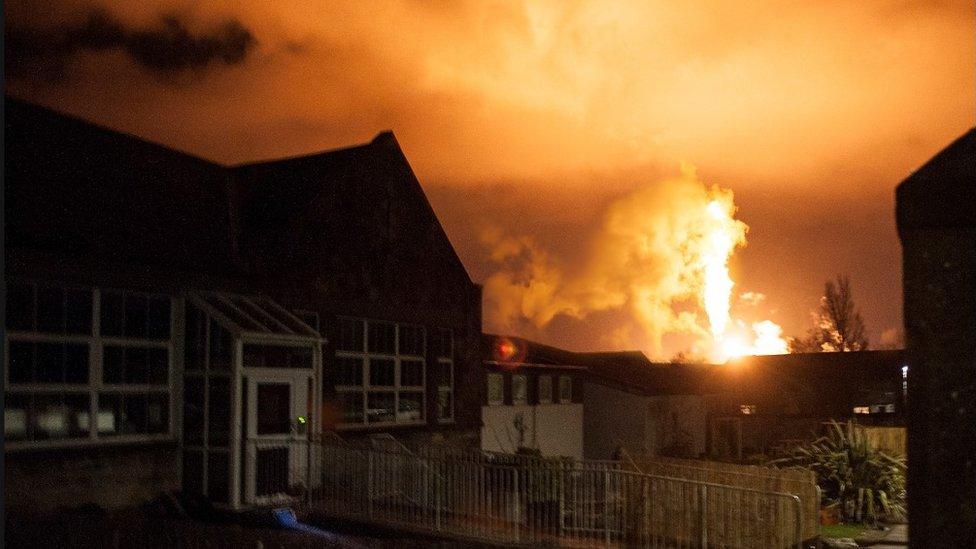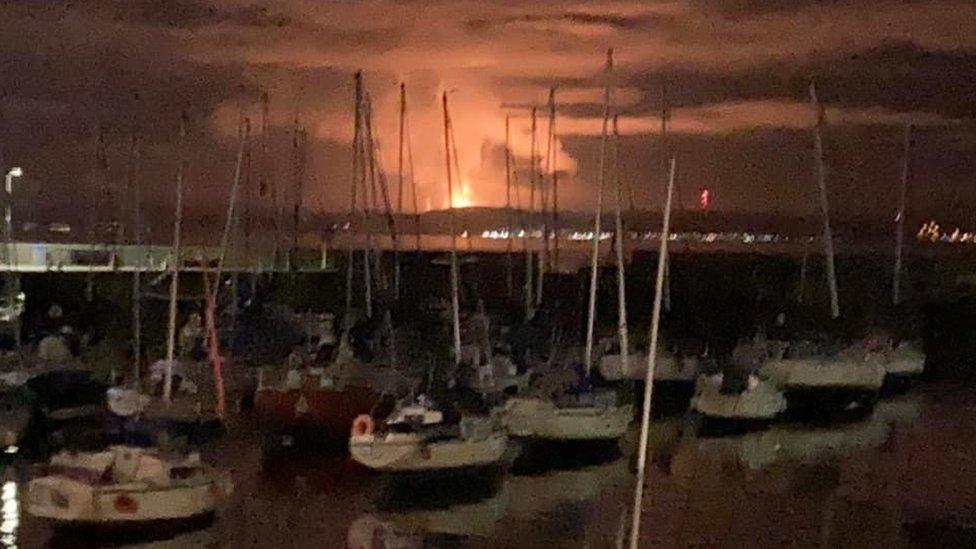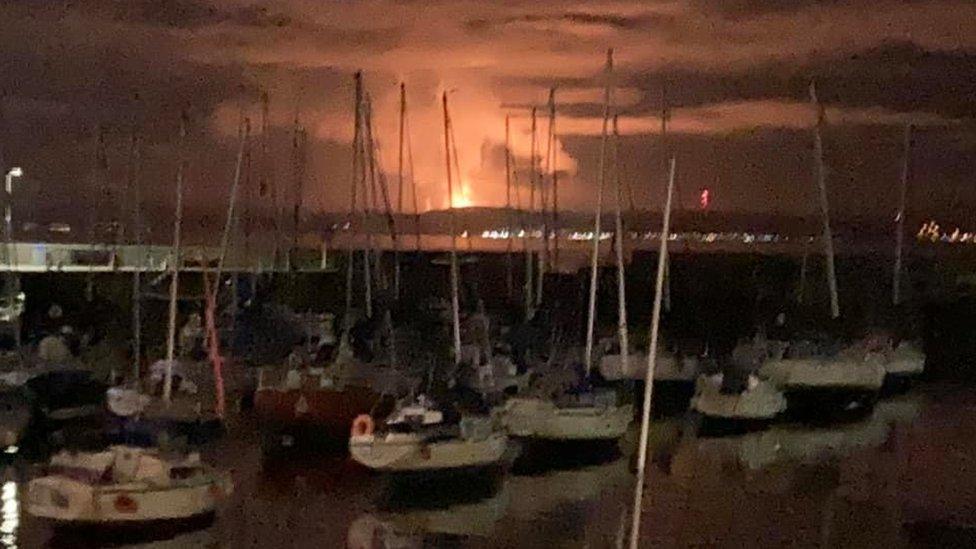Mossmorran: Carbon emissions from flaring revealed
- Published
Flaring at the Mossmorran chemical plant illuminates the night sky
Up to 13,800 tonnes of CO2 could have been emitted from a Fife chemical plant during October flaring, according to figures from the Scottish Environment Protection Agency (Sepa).
The Scottish Greens say that is equivalent to 9,140 people taking a return flight from Glasgow to New York.
The Mossmorran flaring lasted three days from 4 to 6 October.
Fife Ethylene Plant operator ExxonMobil said it was committed to minimising carbon dioxide emissions.
It was the fourth period of elevated flaring at the Exxonmobil plant in 2020.
Green MSP Mark Ruskell said it would take up to 13,800 trees 100 years to offset the same amount of carbon.
He said the climate impact of the flaring was "catastrophic" and renewed calls for a transition plan for the plant.

A previous flaring incident at Mossmorran illuminated the night sky
"Flaring is distressing and highly disruptive for local residents every time this fossil fuel relic suffers a breakdown, but these figures also now show the catastrophic long-term impacts this is having on our environment," he said.
"Scotland has a legally binding target to achieve net-zero emissions by 2045, so it's baffling to find out this much carbon is regularly being burned off into out atmosphere with very little consequence for the operators.
"Work is planned to reduce the impacts of flaring, but it's already been delayed, and as far as I understand it won't have a significant impact on reducing carbon emissions. The operations of this plant fundamentally rely on the burning of huge quantities of fossil fuels, and we urgently need a plan to decarbonise it, or transition away from fossil fuel industries altogether in Scotland."
Chris Dailly, Sepa's head of environmental performance, said: "As one of the organisations regulating Mossmorran, we're clear that compliance with Scotland's environmental laws is non-negotiable.
"Whilst we know limited, controlled flaring is an authorised safety feature of industrial sites and our network of air quality monitors continue to demonstrate no breaches of UK air quality standards, we know only too well the broader impacts on local communities.
"That's why in May we submitted a report in relation to Easter 2019 flaring at the Mossmorran complex to the Crown Office and Procurator Fiscal Service (COPFS) for consideration of prosecution, and why we are requiring the installation of noise reducing flare tips followed by the installation of ground flares."
He added: "ExxonMobil Chemical must take steps to make flaring the exception rather than routine and reduce the impacts when the site does flare and if they don't, Sepa won't hesitate to take further action to ensure they do so."

The flaring could be seen from as far away as Musselburgh in East Lothian
An ExxonMobil spokesman said ''Fife Ethylene Plant (FEP) is committed to minimising CO2 emissions and maximising energy efficiency.
"It is also important to understand that we report and pay for our CO2 emissions under the EU Emissions Trading Scheme (EU ETS), which provides us with added incentive to minimise emissions."
He said the company had implemented a number of innovations in heat integration, such as using waste heat from a gas turbine to reduce fuel consumption in furnaces.
The spokesman added: ''ExxonMobil is pursuing technologies to enhance existing operations and develop alternative energies with a lower carbon intensity."
He said this included:
Researching breakthroughs that make carbon capture and storage technology more economic for power generation and industrial applications
Developing process intensification technologies to reduce the energy needs of manufacturing facilities
Progressing advanced biofuels for commercial transport and petrochemicals
James Glen, chairman of Mossmorran Action Group, said: "Pumping such huge quantities of CO2 into the atmosphere around the plant damages both the environment and human health on an industrial scale. CO2 emissions can create ground-level ozone, which is proven to cause respiratory problems, the most frequently reported impact of flaring reported by local residents.
"Sepa doesn't measure ground-level ozone, the Scottish government does nothing to curb emissions and the NHS does not record health impacts. This needs to change urgently."
- Published5 October 2020

- Published4 October 2020

- Published27 July 2020
![Darren Watt posted a picture online which he described as showing the "most intense [flaring he had] ever seen".](https://ichef.bbci.co.uk/ace/standard/976/cpsprodpb/396B/production/_110899641_eqr5lvdw4aanxra.jpg)
- Published14 May 2020
